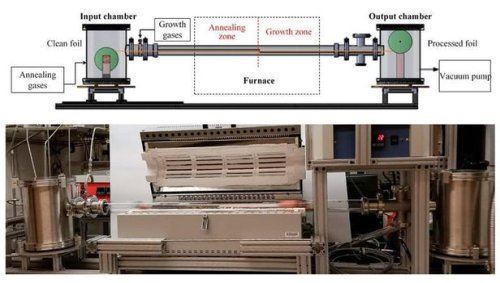Technology suitable for the production of graphene sheets on an industrial scale has been developed
One of the problems that prevents the widespread use of graphene in electronics and other areas is the lack of suitable technology to produce high-purity material on industrial (roll) scales. But recently, researchers from the Massachusetts Institute of Technology managed to find a solution to the problem described above. The technology developed by them already allows to produce custom-made graphene membranes for desalination of water, purification of water from biological impurities, etc. And with due improvement, this technology will allow to produce sheets of high-quality graphene, from which transistors and other elements of electronic chips of the next generations will be made.
Graphene is an ultra-lightweight, ultra-strong and transparent material with a range of other unique properties. It is a form of carbon, the crystal lattice of which has a single-atomic thickness. The structure of graphene resembles a miniature “iron mesh” with such small cells that through the bottom can not seep through some of the smallest atoms – helium atoms. Thus, by making a set size hole in the graphene film, it is possible to obtain a membrane that effectively filters only molecules of a certain type.
The problem with the production of graphene is that this material is literally grown under very special conditions, and to organize the continuous production of graphene tape with width, at which this material can be rolled into a roll, is quite problematic. However, as mentioned above, scientists from the Massachusetts Institute of Technology have developed the technology and embodied it as an experimental installation capable of producing graphene tapes up to 10 meters long at a speed of 5 centimeters per second.

A fairly common method of deposition from the steam phase is used to produce graphene. Graphene film is grown on copper foil, the tape of which passes through two pipes. In the first pipe, the foil is heated to a temperature ideal for the synthesis of graphene, and the environment in the second pipe provides the necessary ratio of methane to hydrogen. And when the gas mixture comes into contact with heated copper foil, graphene begins to form on its surface.
Graphene begins to form in the form of separate disparate “islands” that become more and more unaf medieval and combined into one continuous tape. After the foil with a layer of graphene from the reactor’s bowels, it is covered with a polymer, by which the graphene film is separated from the surface of the foil and which serves as the basis of the graphene membrane.
Researchers tested graphene membranes using water solutions of various salts and other molecules. These tests have shown that graphene, made in a new way, is in no way inferior to graphene obtained by conventional small-series and laboratory methods.
The only drawback of the new method is the need to separate graphene and polymer base, due to the presence of this material can be rolled into a roll. But it will not be difficult to develop an automatic separation procedure and it will be done in the very near futur
e.Source www.dailytechinfo.org